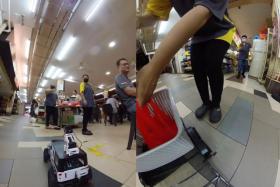When AI can help the IT helpdesk
Machine learning can learn from past data and experiences to deal with low level issues, freeing up staff for more meaningful work
Machine learning is transforming work, not only in manufacturing and logistics but also in the office.
It is already possible to automate routine, repetitive tasks, and the future lies in the application of artificial intelligence (AI) technologies that learn from past data and experience.
Last year, Singapore's National Research Foundation launched AI.SG, a national programme in AI designed to catalyse, synergise and boost Singapore's digital economy of the future.
The programme aims to accelerate the development and adoption of AI and machine learning solutions, starting with such areas as finance, healthcare and city management.
Such initiatives have positioned Singapore strongly to integrate innovation and technologies into the wider economy, complementing its vision to be a smart nation.
Global consultancy company Accenture has reported that by 2035, AI is projected to help double the country's economic growth rates and increase productivity by 41 per cent, adding up to US$215 billion (S$180 billion) in gross value-add.
The AI revolution must take many small steps before its promise is fully realised.
One ubiquitous, labour-intensive area that is ripe for transformation through machine learning is the IT service desk.
Currently, service desk tools' automation is static, has very little built-in intelligence, and requires periodic human intervention to recalibrate.
However, this will change as machine learning applications enable smart automation.
Empowered with fluid smart automation, IT service desk tools will be able to categorise incoming requests, assign them to the appropriate technicians, and suggest solutions without the need for any human support. They will accomplish this by learning from the historical IT service desk data.
Today, IT administrators set up and maintain the automated processes in IT service desks. In dynamic IT environments, these automation rules lack the intelligence to adapt.
But with the application of machine learning, a categorisation algorithm can be trained based on requests from a particular period or 'n' number of historic requests.
This algorithm will be able to perform categorisation more effectively than human-defined rules, and it will continuously learn and fine tune over time.
Help desks are also usually flooded with low-level incidents like password resets and printer configuration requests that end users can resolve by themselves with the help of proper knowledge base articles.
IT administrators often deploy technicians to handle these incidents, which brings down productivity.
AI-based chatbots and virtual assistants can help.
Chatbots can become the end users' first touch point with the IT service desk team, allowing the users to report their issues.
And with the application of machine learning, chatbots can be trained to suggest the top solutions that have worked previously for a given issue.
For example, a chatbot can be trained to help fix printer issues.
So when a user pings the chatbot with a printer issue, the chatbot would respond with the knowledge base article that has worked most of the time for similar issues reported by users.
If the end user is not satisfied or when the chatbot runs out of solutions, it would tag a technician to help.
With such applications of AI on IT service desks, IT administrators will be relieved of trivial chores that eat up their time.
The writer is vice-president of product management at ManageEngine, which offers enterprise IT management software services.
Get The New Paper on your phone with the free TNP app. Download from the Apple App Store or Google Play Store now


